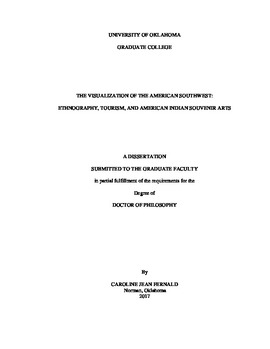| dc.description.abstract | This dissertation addresses the visualization, or artistic documentation, of the American Southwest in the nineteenth and early twentieth centuries. Artistic images in the form of drawings, paintings, photographs, and prints shaped the way Americans conceptualized and understood the Southwest and its Indigenous inhabitants, and through their circulation in popular texts, scientific reports, and marketing materials, were effective in establishing the region as a distinct cultural and geographic zone ripe for tourism. I focus on the interconnections and exchanges between ethnographic texts and images, such as the publications of the Bureau of American Ethnology, Native American and European American artworks produced by Pueblo potters, Nampeyo, John K. Hillers, Elbridge Ayer Burbank, and E. Irving Couse, and the marketing materials of the Santa Fe Railway, the main promoter and creator of the tourist industry in the region. The visualization of the Southwest in scientific reports, artistic renderings, and promotional literature presented the region as a space that existed outside of modernity. Anthropologists, artists, and the Indigenous subjects of their ethnographic inquiry attempted to transcend the passage of time by documenting, in text and image, the memory of the art, culture, and people of the region. I suggest that this documentation was intended to give permanence to a time, place, and culture that was believed to be slipping away. By recording this information in the form of anthropological reports and artistic images and objects, the original source was given a form of permanence that allowed phenomenological resonances of the Indigenous cultures of the Southwest to extend beyond the confines of the region and the temporality of the period. Finally, through an analysis of the interconnectivity of anthropological reports and practices, ethnographic portraiture, and promotional imagery for the tourist market, I argue that American Indians were also engaging in auto-ethnography and self-preservation for the sake of future generations by replicating their culture through the acts of sharing protected knowledge and materials with anthropologists, modeling for artists, and producing traditional arts en masse for sale to tourists. | en_US |
